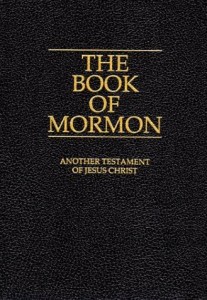Prophecies
The second DVD in the Journey of Faith series discusses the religious milieu, culture, the land, and language surrounding the descendants of Lehi and Sariah in the New World. Lehi’s son, Nephi, begins the Book of Mormon account in 600 bc, preserving it by engraving on metal plates. The narrative did not come to light until the 1820s, when by divine revelation, Joseph Smith was directed to the plates and unearthed them from a hill in upstate New York. From them he translated the Book of Mormon: Another Testament of Jesus Christ.
 The Book of Mormon contains accounts by several different people over a thousand years, harmonized into a whole narrative by a father and son, Mormon and Moroni, who lived around 400 ad., including the visit of Jesus Christ to the Nephite people in the Americas after His resurrection.
The Book of Mormon contains accounts by several different people over a thousand years, harmonized into a whole narrative by a father and son, Mormon and Moroni, who lived around 400 ad., including the visit of Jesus Christ to the Nephite people in the Americas after His resurrection.
This article surveys the prophecies of Jesus Christ’s birth, ministry, crucifixion, and resurrection contained in the Book of Mormon.
What is a Prophet
The word “prophet” comes from the Greek prophetes, which means “inspired teacher.” Although neither the Greek term nor its Hebrew equivalent, nabi, initially required the function of foretelling, all prophecy looks to the future. Since the Lord has chosen some of his servants to be foretellers—to disclose, sometimes in specific terms, momentous events that are to occur—the predictive element often overshadows other implications of the word in the minds of some. . . . By scriptural definition, a prophet is anyone who has a testimony of Jesus Christ and is moved by the Holy Ghost (Revelation 19:10).[1]
As John W. Welch reports,
Hugh B. Brown has defined eleven characteristics that “should distinguish a man who claims to be a prophet.”. . . (1) “He boldly claim[s] that God has spoken to him”; (2) he is “a dignified man [bearing] a dignified message”; (3) he “declare[s] his message without fear”; (4) he bears witness without argument or concession; (5) he “speak[s] in the name of the Lord”; (6) he “predict[s] future events . . . [that] come to pass”; (7) his message pertains to future as well as present generations; (8) he “endure[s] persecution”; (9) he “denounce[s] wickedness fearlessly”; (10) he does “things that no man could do without God’s help”; and (11) “his teachings [are] in strict agreement with scripture.”[2]
Prophets in the Book of Mormon received remarkable visions of Jesus Christ and His life and ministry. Old Testament prophets such as Moses, Samuel, Isaiah, and Enoch have recorded their experiences with God. The Book of Mormon has brought to light the testimony of other Old Testament prophets that were not included in the canon and have since been lost.[3] The New Testament records such cataclysmic experiences as Paul’s vision of Jesus Christ on the road to Damascus (see Acts 9).
Book of Mormon Prophecies of Christ
When we think of Jesus Christ in the Book of Mormon, inevitably we are drawn toward the book of Third Nephi where Christ’s visit to the Americas and His preaching and teaching to the people and His Nephite Apostles is recorded in great detail. But long before that epic event, knowledge of His birth, death, and resurrection was given to the Nephite prophets.
Lehi
Lehi’s calling as a prophet is simply recorded by Nephi:
Wherefore it came to pass that my father, Lehi, as he went forth prayed unto the Lord, yea, even with all his heart, in behalf of his people. And it came to pass as he prayed unto the Lord, there came a pillar of fire and dwelt upon a rock before him; and he saw and heard much; and because of the things which he saw and heard he did quake and tremble exceedingly (1 Nephi 5–6).
After that experience, Lehi was favored with a second vision of God the Father, the Son, and the twelve Israelite Apostles:
And it came to pass that he saw “God sitting upon his throne, surrounded with numberless concourses of angels in the attitude of singing and praising their God. . . . He saw One descending out of the midst of heaven, and he beheld that his luster was above that of the sun at noon-day. And he also saw twelve others following him, and their brightness did exceed that of the stars in the firmament. (1 Nephi 8–10)
This was later followed by an iconic vision for Latter-day Saints, that which culminated in the Tree of Life (see 1 Nephi 8). This vision was shared by Lehi’s son, Nephi, who was given an invaluable interpretation by a heavenly messenger.
Nephi
In 1 Nephi 11–14, Nephi is taken through his father’s vision by a heavenly messenger or “Spirit.” But in addition to what was recorded by Lehi, Nephi is privileged to see the future not only of his own people, but also that of his native land. For our purposes, however, what is most important is the vision Nephi has of the life of the Savior, Jesus Christ.
Sometime between 600 and 592 bc, before Lehi’s little band embarks on the longest part of their journey across Arabia, Nephi learns that Jesus Christ, the Son of the Eternal Father, will be born to a virgin of Nazareth (1 Nephi 11:18–20) and that this gift is a manifestation of the love of God (v. 22). He learns of Christ’s baptism at the hands of John the Baptist, the forerunner (v. 27), His ministry, including the calling of the Twelve Apostles, and the miracles He will perform (vv. 28–31). Nephi is then shown the judgment of Christ and His crucifixion (vv. 32–33), and finally the coming apostasy when “the multitudes of the earth, . . . were gathered together to fight against the apostles of the Lamb,” (v. 34).
The next chapter deals with the fate of Lehi’s posterity. The darkness that fell upon Israel at Christ’s crucifixion is to be mirrored and expanded in the New World as Nephi describes that he saw:
…a mist of darkness on the face of the land of promise; and I saw lightnings, and I heard thunderings, and earthquakes, and all manner of tumultuous noises; and I saw the earth and the rocks, that they rent; and I saw mountains tumbling into pieces; and I saw the plains of the earth, that they were broken up; and I saw many cities that they were sunk; and I saw many that they were burned with fire; and I saw many that did tumble to the earth, because of the quaking thereof. (1 Nephi 12:4).
But again Nephi sees Jesus Christ as He appears to the Nephites, “And I saw the heavens open, and the Lamb of God descending out of heaven; and he came down and showed himself unto them” (v. 6). Nephi sees that the Lord will again call twelve Apostles from among the Nephites (vv. 7–10). He then sees the eventual destruction of his people (vv. 19–23).
Nephi’s vision of the Savior, as he taught it to his people, is as detailed a prophecy of Jesus Christ as one could hope for—occurring some 600 years before Christ was born in Israel.
Benjamin
Some 450 years later, around 130 bc, a righteous Nephite king, King Benjamin, calls his people together at a temple in Zarahemla to pass the kingdom on to his son, and to recount to them the revelation he had received regarding Jesus Christ.[4] With great conviction, Benjamin testifies, “For behold, the time cometh, and is not far distant, that with power, the Lord Omnipotent who reigneth, who was, and is from all eternity to all eternity, shall come down from heaven among the children of men, and shall dwell in a tabernacle of clay” (Mosiah 3:5). Benjamin details Christ’s life and ministry, and His name, “And he shall be called Jesus Christ, the Son of God, the Father of heaven and earth, the Creator of all things from the beginning” (v. 8).
After prophesying of Christ’s death and resurrection, Benjamin explains, “For behold, and also his blood atoneth for the sins of those who have fallen by the transgression of Adam, who have died not knowing the will of God concerning them, or who have ignorantly sinned” (v. 11).
King Benjamin’s speech was to unite his people in faith in Jesus Christ and a renewed determination to live righteously.
Samuel
Unfortunately, in a cycle that is repeated several times in the Book of Mormon, this determination waned. But missionaries to the Lamanites (descendants of Laman and Lemuel who were sworn enemies of the Nephites) had met with considerable success as the time for Christ’s visit approached.
And now it came to pass in the eighty and sixth year, the Nephites did still remain in wickedness, yea, in great wickedness, while the Lamanites did observe strictly to keep the commandments of God, according to the law of Moses. And it came to pass that in this year there was one Samuel, a Lamanite, came into the land of Zarahemla, and began to preach unto the people (Helaman 3:1–2).
Samuel was cast out of the city once for saying things the Nephites did not want to hear, but instructed by the Lord to go back. The Nephites would not allow him back in, so he got up on a wall and began to prophesy. After calling the Nephites to repentance in no uncertain terms, Samuel was privileged to bear the greatest tidings in the history of the world:
Behold, I give unto you a sign; for five years more cometh, and behold, then cometh the Son of God to redeem all those who shall believe on his name. And behold, this will I give unto you for a sign at the time of his coming; for behold, there shall be great lights in heaven, insomuch that in the night before he cometh there shall be no darkness, insomuch that it shall appear unto man as if it was day. Therefore, there shall be one day and a night and a day, as if it were one day and there were no night; and this shall be unto you for a sign; for ye shall know of the rising of the sun and also of its setting; therefore they shall know of a surety that there shall be two days and a night; nevertheless the night shall not be darkened; and it shall be the night before he is born. And behold, there shall a new star arise, such an one as ye never have beheld; and this also shall be a sign unto you. And behold this is not all, there shall be many signs and wonders in heaven (Helaman 14:2–6).
This came to pass exactly as Samuel prophesied, and in the second article in this series, we will examine the account of Christ’s ministry to the Nephites in the Book of Mormon.
[1] Encyclopedia of Mormonism, sv “Prophet,”.
[2] John W. Welch, “The Calling of Lehi as a Prophet in the World of Jerusalem”, citing Hugh B. Brown, Eternal Quest (Salt Lake City: Bookcraft, 1956), 130–31.
[3] See for example, the testimony of Zenos, Neum, and Zenock ((1 Nephi 19:10; Jacob 4; 3 Nephi 10:14–16).
[4] King Benjamin’s speech, comprising Mosiah 2–6, is fully covered in John W. Welch and Stephen D. Ricks, eds., King Benjamin’s Speech: That Ye May Learn Wisdom.

